History
San Michele was the name saint of the church of the monastery which began construction
here in 1295 by the Camaldolese Order - a branch of the Benedictines founded in 1012 by the
hermit St. Romuald (c.951-1027) at Camaldoli, near Arezzo, hence their
name. Don Rorlando of that order had been sent to Florence in 1294 to
establish the order there, a move suggested and initially funded by the
aristocratic poet Frate Guittone of Arezzo, who didn't live to see his
vision come to fruition, but whose piety and generosity Dante writes of in
his Commedia. That an order devoted to the hermit lifestyle should
want to establish itself in such an urban environment is thought to be due
to the then prosperity and wealth of the city and its nobles and
merchants. Within the previous few years Santa Maria Novella had been
built and Santa Croce and the Duomo had seen rebuilding and expansion. As
the foundations were being dug the bishop of Florence led a procession of
worthies to the monastery site, bearing gifts monetary and liturgical.
Onlookers also spontaneously threw money, amounting to 250 lire, which
equalled the amount the order had paid for the land, previously owned by
the Alluodi family. The complex was originally built to house just six,
including Don Rorlando. It amounted to a small church, cells, a refectory
and a meeting room. The original six monks, including Don Rorlando, must
have found the going tough, as they returned to Camaldoli after a few
years, and were replaced by another six, led by one Don Romualdo, who seem
to have faired better. Numbers then swelled from six to sixty and then to ninety,
so rebuilding was swift and considerable.
The history of the monastery was recorded in the Registro Vecchio,
begun probably in the 1360s, and the identical Registro Nuovo, both
kept by the monks, and the reason there is so much information about the
place, and why this page is so detailed.
The original church was small, austere, choirless and aisleless and served
just the monastic community throughout the 14th century. An unusual
feature was, by 1297, the chiesetta, a space running along the east
of the church solely for the use of female patrons. It had an altar, an
altarpiece and a grill through which the women could have limited contact
with the monks. A little later a choir for the monks was added, protruding
and making an odd L-shape sticking out from the apse end beyond the end of
the chiesetta. The early 14th century saw the convent grow and
become an established Florentine institution, patronised by rich families,
like the Spini and a native Florentine prior appointed (Don Filippo degli
Nelli) in 1322. By 1330 all twenty-two members of the community were
Florentine and it is thought to be the need to teach young novices the
liturgy that was second nature to the earlier monks from Camaldoli that
lead to the borrowing of none books from the convent of San Pietro di
Poteoli in 1322 and the establishment of a scriptorium to copy said books
within a decade.
The plague of 1348, which swept Europe and
saw off three quarters of the city's population, also resulted in the deaths of
seventeen of Santa Maria degli Angeli twenty-two monks. But the widespread
belief that the pestilence had been God's punishment for man's wickedness
resulted in considerable donations of money and children by those
remaining and benefiting from the drastic lessening and shifting of
resources, both human and financial, following the plague. The new donors
included an ironmonger. So, new money and old money together resulted in
the convent's best time yet for donations and building work, notably the
new chapter house to house the complex's growing number of monks.
Altarpieces too, notably from the workshop of Nardo di Cione. Lesser, but
still major, outbreaks of the plague kept levels of penitence and
donation steady through most of the 14th century, with the Albizzi family
the major financiers. It was mostly their money which paid for the major
work improving the church in the years leading up to completion on
Christmas Day 1374.
The complex was sacked in 1378 during the
rising of the ciompi, who saw Santa Maria degli Angeli as
unacceptably patrician-funded. A fire started in the infirmary soon spread
and resulted in the death of two monks. Only divine intervention, in the
shape of a miraculous gale, prevented the complete destruction of the
convent. Many early altarpieces were lost too. It wasn't until the wealthy
families, the Albizzi faction again foremost, regained power in 1382
that funding began to flow to repair the considerable damage wrought
during the sacking. The moribund scriptorium was revitalised at this time
too, and many burial chapels paid for and embellished with altarpieces.
During the Great Schism of 1409-1414 one of
the claimants to papal authority, Pope John XXIII, spent time in exile in
religious houses around Florence, from 1413 until is death in 1419. Since
1410 Pope John had worn a prized relic, John the Baptist's right index
finger, on a chain around his neck. In 1413 he secretly left this relic in
the safe keeping of Santa Maria degli Angeli, It's presence here was known
only to the monks, Cosimo de' Medici and and Matteo da Viterbo, the pope's
confessor. It was kept here for eight years, only passing into the
Florence Baptistery two years after John's death.
The late 15th century saw something of a decline, following the glory days
leading up to the installation of Lorenzo Monaco's altarpiece.
Remodelled in 1676, the church has a ceiling vault
fresco by Alessandro Gherhardini of 1700. The Chiostro degli Angeli has fresco
lunettes by Bernardino Poccetti, as does the dome of the Ticci Chapel off
of it from 1599. He also probably painted the altarpiece in the chapel.
The former refectory, off the Chiostro dei Morti, contains a 1543 Last Supper by Ridolfo del
Ghirlandaio (Davide's nephew) which was restored in 2000.
Suppressed in 1808, with the manuscripts going to the Biblioteca Laurenziana. The buildings are now used mostly by the university,
the church for lectures. Much of the rest of the complex has been absorbed
into the Santa Maria Nuova hospital.
A fragment of a fresco of the Pieta by Fra Angelico from c1424-28
is kept here, despite it being from a similarly-named convent of Santa
Maria degli Angiolini on Via della Collona.
The rotunda
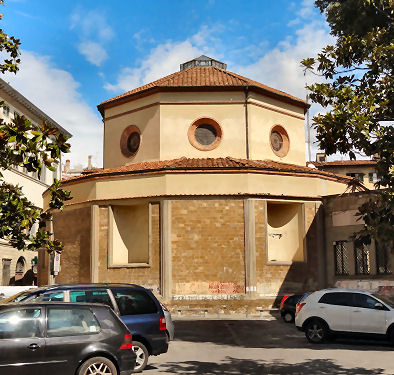 In 1434 Brunelleschi was commissioned by Matteo and Andrea Scolari (the
heirs of condottiere Filippo Scolari aka Pippo Spano) to
design another church for the monastery. His original design was
probably inspired by ancient Roman temples and was the first centralized
building of the Renaissance. It consisted of a a domed octagon with 8
radiating chapels linked by a narrow passageway that pierced the apses and
served as an ambulatory around the octagon, and with a sixteen-sided
exterior. The altar would have been in the centre. Construction progressed
quite rapidly but was halted due in 1437 when the Scolari funds were
confiscated to help pay for the war against Lucca. The building had
reached a height of about seven metres. Around this time it acquired its
nickname of Il Castellacio - the broken-down castle. In the 17th
century the shell was finally given a simple wooden roof, but it still
deteriorated rapidly. I have a guidebook, written in 1900 by Edmund
Gardner, which describes Brunelleschi's building as a 'rather picturesque bit of ruin'. The
building, which had been put to various uses, was repaired and acquired
its current (and controversial) appearance after rebuilding in 1937 by
Rodolfo Sabatini. It was given to the university and, you will read
elsewhere, thus became known as the Rotonda degli Scolari, but I'd hazard
a wild guess that it's so called because of the name of the brothers who
first built it. In 1434 Brunelleschi was commissioned by Matteo and Andrea Scolari (the
heirs of condottiere Filippo Scolari aka Pippo Spano) to
design another church for the monastery. His original design was
probably inspired by ancient Roman temples and was the first centralized
building of the Renaissance. It consisted of a a domed octagon with 8
radiating chapels linked by a narrow passageway that pierced the apses and
served as an ambulatory around the octagon, and with a sixteen-sided
exterior. The altar would have been in the centre. Construction progressed
quite rapidly but was halted due in 1437 when the Scolari funds were
confiscated to help pay for the war against Lucca. The building had
reached a height of about seven metres. Around this time it acquired its
nickname of Il Castellacio - the broken-down castle. In the 17th
century the shell was finally given a simple wooden roof, but it still
deteriorated rapidly. I have a guidebook, written in 1900 by Edmund
Gardner, which describes Brunelleschi's building as a 'rather picturesque bit of ruin'. The
building, which had been put to various uses, was repaired and acquired
its current (and controversial) appearance after rebuilding in 1937 by
Rodolfo Sabatini. It was given to the university and, you will read
elsewhere, thus became known as the Rotonda degli Scolari, but I'd hazard
a wild guess that it's so called because of the name of the brothers who
first built it.
|
|

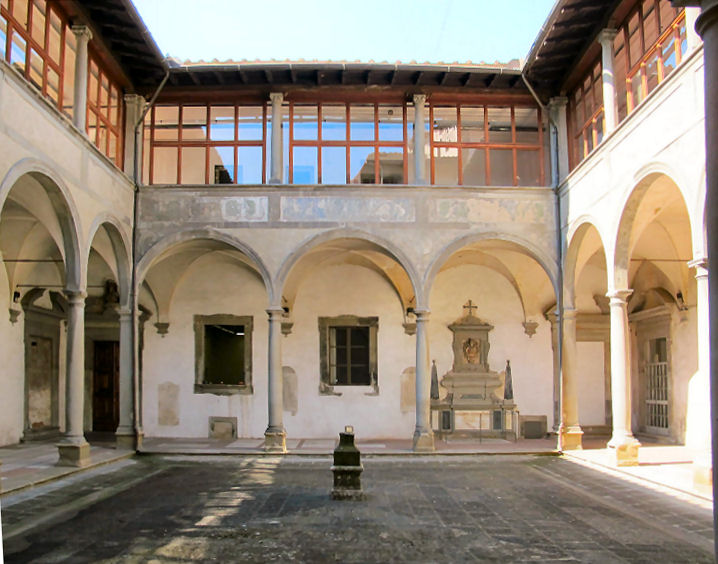
The Chiostro dei Morti

Illumination and Lorenzo Monaco
A renowned scriptorium flourished here from the 13th
Century. Vasari, writing a hundred years after, wrote that a Don Giacobbo and
a Don Silvestro were the monk/artists to be credited. This 'fact' seems to
be based on legend, however, and relies on the confusing of three separate
monks called Silvestro and his having the wrong Jacopo and Silvestro
buried in the same tomb. These errors lead to the citing of Don Silvestro dei Gherarducci
as a major artistic talent, an assertion which took a knock when his one
signature (on one of the dozen excised miniatures acquired by William
Young Ottley from the monastery, along with the Crucifixion
altarpiece mentioned in Lost art below) was found to be a late
18th/early 19th century forgery. Disagreement still rages, though, with
the four cuttings in the Fitwilliam Museum still safely attributed to Don
Silvestro dei Gherarducci and associates in the catalogue of their 2016
exhibition Colour - the art and science of illuminated manuscripts. Don Giacobbo dei Francheschi does seem to
have been a major contributor to the artistic excellence of the
scriptorium, though, even though the major part of the illumination work
in his time is now thought to have been contracted out to lay artists.

It was
here that Lorenzo Monaco established himself as both a manuscript
illuminator and a painter, although it's probable that his production of
panels and frescoes date to the years after he left. From whom he received his training is undocumented
and hence the subject of much scholarly conjecture and argument - Agnolo
Gaddi and Jacopo di Cione are mentioned, the latter seeming more likely.
Lorenzo became a fully-fledged member in 1391 and then a deacon in 1395,
after which his name disappears from the monastic legers, suggesting that
this is when he moved out
of the
monastery, but he maintained links - he painted the majestic Coronation
of the Virgin of 1414 (see below), the monastery sold him a house
and studio (right opposite the church doors and for a pittance) in 1415, and when he died (c.1424) he was buried
in the chapterhouse here.
This is an initial S, with Christ Giving
the Keys to St Peter,
by Lorenzo Monaco. It is now in Washington, cut
from
a choir book now in the Biblioteca Laurenziana.
|
|
Lost art
The centre panel of Nardo di Cione's workshop's Coronation of the Virgin, 'almost certainly'
from the Albizzi chapel of the Ognissanti in the infirmary here, is now in the Victoria and Albert Museum in London.
The wings depicting saints are in the Alte Pinakothek in Munich. His
Trinity painted for the Ghiberti chapel in the rebuilt chapter house here is in the Accademia's Orcagna Room and his
Virgin and Child enthroned with flanking panels depicting Saints Gregory and Job
and predella panels showing The Trials of Job, is now in the small
room beyond the sacristy in Santa Croce. Both were installed in 1365.
Also dating to around 1365 is a very nice panel depicting The
Enthroned Christ Adored by Angels by Giovanni da Milano, part of a now
dispersed polyptych, now in the Brera, Milan.
Noli mi Tangere (probably) by Jacopo di
Cione, a a pinnacle panel from an altarpiece of c.1368/70 possibly from the Palagio chapel,
dedicated to Saint Peter, also in the rebuilt chapter house, is now in the National Gallery in
London. Two more panels said to be from the same altarpiece are in the MET in New
York (The Crucifixion), Denver (The Pieta) and Rome
and Luxembourg (Female Saints and Male Saints respectively.
Six pilaster saints are on loan to the National Gallery from the church of
Saint Mary Magdalene in Littleton, Middlesex, three more are in a private
collection. Six angels are in the Lehman collection too.
The Baptism of Christ, with Saints Peter and Paul and Scenes from the
Life of Saint John the Baptist by Niccolò di Pietro Gerini,
commissioned in 1386 by one of the monks, Don Filippo Nerone Stoldi, in
memory of his mother, for the Stoldi chapel in the infirmary is now in the
National Gallery
in London,
having spent some of the time between 1414 and 1580 at another Camaldolese
house, San Giovanni Decollato del Sasso.
(The flanking saints stand on a carpet imitating the design of one in the Nardo di Cione works mentioned above.)
A pair of panels depicting the Annunciation, now in the Feigen
Collection, are thought to have originally been pinnacle panels on this
altarpiece, with a Salvator Mundi, now in the Munich Alte
Pinakothek, over the centre panel. A Crucifixion by the same
artist, now in the Accademia, is known to have come from here, due to its
inclusion in the list of works looted by Napoleon, possibly having been
sited in the refectory.
The Virgin and Child Enthroned with Saints John the Evangelist
and John the Baptist to the left and Saints James the Great and
Bartholomew to the right (see right), painted mostly by Agnolo Gaddi, assisted by
Lorenzo Monaco, in 1387-88 for
the Nobili Chapel (which survives) the chapel off the west cloister
founded by Bernardo di Cino Bartolini Benvenuti de’ Nobili, was
dismembered in 1808 during the Napoleonic suppression. The main tier is now in the Berlin
Gemäldegalerie (but was not on display when I was there in October 2015). Its predella panels
are early works by Lorenzo Monaco
which are in the Louvre (The Banquet of Herod, The Crucifixion, and a
single panel showing two Episodes from the life of the Apostle
James, all looking very much like finely-wrought manuscript
illuminations), the National Gallery in London (The Baptism of Christ) , the Alana Collection in
Newark, Delaware, and the Feigen Collection in New York. Four saints from the
pilasters are in the Clowes Collection, Indianapolis/Newfields Museum, and
four more, formerly in Göttingen, are now in the Berlin Gemäldegalerie.
These eight saints are usually given to Agnolo.
A Virgin and Child with Saints by Mariotto di Nardo, now in the
church of Santa Margherita a Tosina, outside Florence, is said to have
been painted for the da Filicaia chapel in the west cloister here in 1389.
An early work by Lorenzo Monaco, The Agony in the Garden, now in
the Accademia. It was painted around the time of his departure from Santa
Maria degli Angeli in 1395 to establish himself as an independent artist and
may have been a supportive commission by his former brethren.
A detached fresco fragment by Lorenzo Monaco showing
Christ in Piety (or The Man of Sorrows) from c.1411-1413 is
in the Innocenti Museum. It is said to have been in the Oratory of the
Alberti family here, now lost.
Lorenzo Monaco's only signed, and arguably most important, work is the spectacular
Coronation of the Virgin of 1414 (see right) painted for
the high altar here, now in the Uffizi. Saint Zenobius is here identified
by the Florentine lilies stamped into his halo, a detail surely hardly
visible to the naked eye. The three right-hand panels in the
predella are by Fra Angelico, who was assisting Lorenzo at the time. Another
Coronation of the Virgin by Lorenzo, called the San Benedetto
Altarpiece, of 1407-9, is in the National Gallery, London. It was
painted for the monastery of San Benedetto fuori della Porta Pinti, but
came here, when that monastery was demolished during the siege of
Florence, to
the Alberti Chapel. More panels from this altarpiece survive, three from
the predella are in the National Gallery and of the pinnacles, an
Annunciation is possibly one now in Pasadena and the Redeemer Blessing
in the centre could possibly be a panel once belonging to the art
historian Charles Loeser and still in private hands.
The odd trilobe-topped Last Judgement panel by Fra Angelico
from c.1425/28 was said by Vasari to have been sited to the right of the
high altar here. Whether this explains its original purpose, and where
it might have been sited before, continue to be controversial amongst
art historians. It could've been an overdoor, a chair back, or intended
for the cemetery here. It is now in the Museo di San Marco.
Andrea del Castagno's fresco of the Crucifixion of c.1453 (see
below right) now in the Cenacolo di Sant'Appolonia, includes the Virgin, Saints
John the Evangelist, Benedict and Romuald. It was in the fifth
cell of the second cloister here, above the garden. It was removed in the
20th century and is badly damaged. Another, even earlier, fresco of the
Crucifixion by Andrea from here is now in the offices of the hospital
of Santa Maria Nuova. It has the same saints, plus Mary Magdalene.
A fresco attributed to Davide Ghirlandaio of a
Crucifixion with Saints Benedict and Romuald, said to have come
from the cloister here, is in
the Andrea del Sarto Cenacolo Museum at
San Salvi.
Alessandro Allori's flower-filled
Coronation of the Virgin of 1593 is now in the left wing of the Tribune at
the Accademia.
The bronze Reliquary of Saints Protus, Hyacinth and Nemesius by Lorenzo
Ghiberti, from 1425-8, was set against the wall of the Ticci Chapel inside
the convent here, but with an arched opening above it onto the street,
enabling the veneration of the 3rd-century martyrs' relics by passers by.
These relics had been transported here on 7th January 1422, in a
procession, carried by Archbishop of Florence, Amerigo Corsini, from the
defunct San Salvatore
in Selvamonda, another Camaldolese abbey. This handsome reliquary,
sponsored by Cosimo and Lorenzo de' Medici. is now in the Bargello. Its marble step remains here, having been found in 2011.

Bibliography
George R Bent - Monastic art
in Lorenzo Monaco's Florence: painting and patronage in Santa Maria degli
Angeli, 1300-1415
from the Codex Rustici of c.1447
|
|
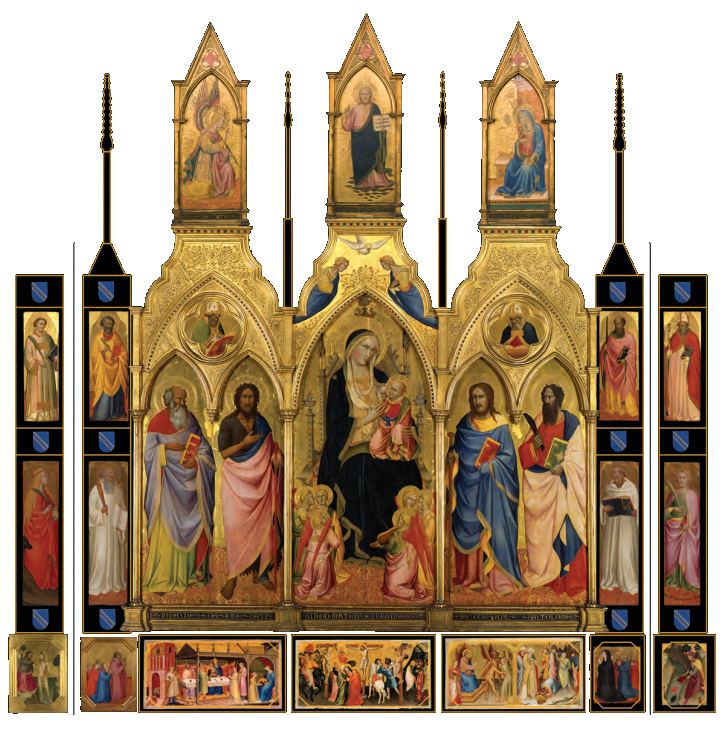
The Virgin and Child Enthroned by Agnolo Gaddi,
assisted by Lorenzo Monaco
(Reconstruction for an article in the January 2020 Burlington Magazine by
Dillian Gordon)
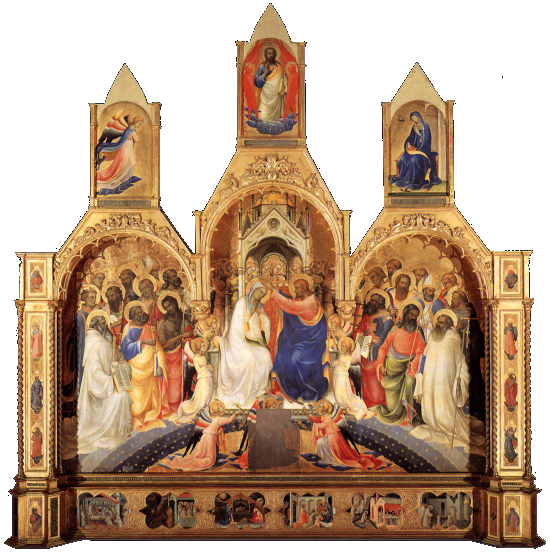
Lorenzo Monaco's
Coronation of the Virgin of 1414
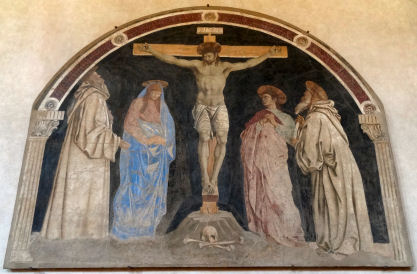
|
 In 1434 Brunelleschi was commissioned by Matteo and Andrea Scolari (the
heirs of condottiere Filippo Scolari aka Pippo Spano) to
design another church for the monastery. His original design was
probably inspired by ancient Roman temples and was the first centralized
building of the Renaissance. It consisted of a a domed octagon with 8
radiating chapels linked by a narrow passageway that pierced the apses and
served as an ambulatory around the octagon, and with a sixteen-sided
exterior. The altar would have been in the centre. Construction progressed
quite rapidly but was halted due in 1437 when the Scolari funds were
confiscated to help pay for the war against Lucca. The building had
reached a height of about seven metres. Around this time it acquired its
nickname of Il Castellacio - the broken-down castle. In the 17th
century the shell was finally given a simple wooden roof, but it still
deteriorated rapidly. I have a guidebook, written in 1900 by Edmund
Gardner, which describes Brunelleschi's building as a 'rather picturesque bit of ruin'. The
building, which had been put to various uses, was repaired and acquired
its current (and controversial) appearance after rebuilding in 1937 by
Rodolfo Sabatini. It was given to the university and, you will read
elsewhere, thus became known as the Rotonda degli Scolari, but I'd hazard
a wild guess that it's so called because of the name of the brothers who
first built it.
In 1434 Brunelleschi was commissioned by Matteo and Andrea Scolari (the
heirs of condottiere Filippo Scolari aka Pippo Spano) to
design another church for the monastery. His original design was
probably inspired by ancient Roman temples and was the first centralized
building of the Renaissance. It consisted of a a domed octagon with 8
radiating chapels linked by a narrow passageway that pierced the apses and
served as an ambulatory around the octagon, and with a sixteen-sided
exterior. The altar would have been in the centre. Construction progressed
quite rapidly but was halted due in 1437 when the Scolari funds were
confiscated to help pay for the war against Lucca. The building had
reached a height of about seven metres. Around this time it acquired its
nickname of Il Castellacio - the broken-down castle. In the 17th
century the shell was finally given a simple wooden roof, but it still
deteriorated rapidly. I have a guidebook, written in 1900 by Edmund
Gardner, which describes Brunelleschi's building as a 'rather picturesque bit of ruin'. The
building, which had been put to various uses, was repaired and acquired
its current (and controversial) appearance after rebuilding in 1937 by
Rodolfo Sabatini. It was given to the university and, you will read
elsewhere, thus became known as the Rotonda degli Scolari, but I'd hazard
a wild guess that it's so called because of the name of the brothers who
first built it.